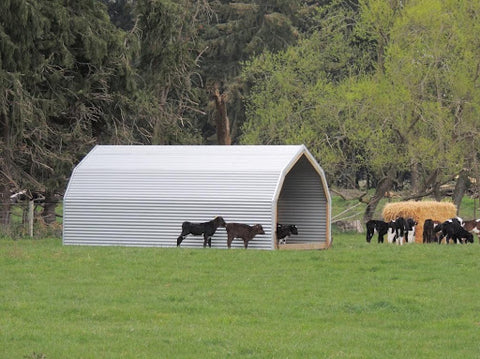Paddock shelters for your calves, alpacas, pigs, goats or lambs!

Outpost Buildings’ livestock shelters, like nearly all of our kitsets, are designed to be portable. This allows you total control over where your shelters are, and when. Best of all, this portability allows you to bring your shelter with you when you move, or sell it if you don’t need it any more.
Outpost livestock shelters are relocatable so they can be moved to fresh ground or repositioned when required. Small shelters can even be towed by a 4 wheeler!
All of our paddock shelters are mounted on top of a heavy duty timber skid base. The skids have holes pre-drilled in the ends of them that you can put a rope through and then drag your paddock shelter across the paddock to fresh grass. Easy! Just take it slowly and avoid rocks or big bumps that the building might snag on.

Wind Anchors
If you have a particularly windy site that you want to put your paddock shelter in, then we recommend you position it with the open side facing away from the wind (your animals will appreciate this) and also anchor it down. We sell two different types of wind anchors for our buildings. For all of our small buildings the option pictured above is great. It is a very basic design made with waratahs that have a chain attached to them for you to attach to the holes in the skids. This will prevent your buildings from moving if it catches a strong gust of wind.
Rest assured that your Outpost livestock shelter is very strong and designed to take all that mother nature can throw at it! Don't just take our word for it, check out our testimonials page.

Customer Testimonial:
"My husband and I are thrilled with our barn. It was easy to assemble with good instructions. Our new calves just love the barn and run to get into it to have their hay and calf meal in the evening and then they stay overnight and are let out in the morning. We have put a feeder, hay and a water bin in there for them and we also put a metal gate and iron on the front of the gate to keep the wind out overnight. You will see from the photos that we have put a windsock on the barn so that when it is shifted each day, it is positioned out of the wind. Thanks again for your help and input.
Regards Julia & Steve"

If you want to move your paddock shelter further away then you can get it lifted onto a hiab truck. This makes it easy to move your building with you if you want to, or you could even sell it if you don’t need it anymore.
Paddock Shelter for your calves
Calves are valuable assets to any livestock farmer. It is therefore essential to ensure that they are kept in the best possible conditions to thrive and grow into healthy adults. One of the most important factors to consider when rearing calves is providing them with quality shelter and protection from harsh weather elements.
Calves will grow faster and are less likely to get illness or disease if they have access to quality shelter and protection from cold wind and rain. A paddock shelter should provide a dry environment for the calves to rest, feed, and grow. It is best to allow at least 1.52m of floor space per calf in a paddock shelter. This space will provide enough room for the calves to move around freely and comfortably.
If you have more than 12 calves, it is advisable to use more than one paddock shelter to separate age groups to reduce the risk of any illness or disease spreading through your whole herd. This strategy can help in identifying any sick calves early and isolating them to prevent the spread of illness to other healthy calves.
Relocatable paddock shelters are great if you do not have a shed to house your calves in. They are affordable and provide shelter for your calves, which can be moved around the paddock over fresh grass regularly. This method can reduce the risk of illness and ensures that the calves have access to fresh grazing, which is essential for their growth.
Permanent paddock shelters in a barn will need to be regularly cleaned out and disinfected to prevent your calves from getting sick. It is crucial to add fresh wood chips to cover the floor of your paddock shelter regularly. The flooring of your paddock shelter needs to be cleaned or changed regularly to remove waste and prevent illness or disease. Untreated wood shavings are a good option for calf bedding.

Positioning the paddock shelter
When constructing a paddock shelter, it is important to consider its orientation. The shelter should be positioned facing the morning and midday sun and placed somewhere with good drainage to prevent it from getting muddy. The back of the shelter should face into the prevailing wind if possible. This orientation will provide a place for the calves to go out of the wind and help prevent your shelter from blowing away or getting damaged.
Providing quality paddock shelter and protection from harsh weather elements is crucial for rearing healthy calves. It is essential to consider factors such as floor space, shelter type, and orientation when constructing a paddock shelter for your calves. Proper maintenance of the paddock shelter, including regular cleaning and disinfecting, is vital in preventing the spread of bacteria and disease and promoting the growth and development of your calves.




